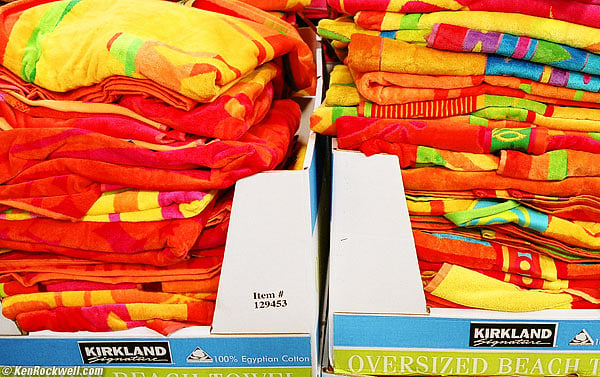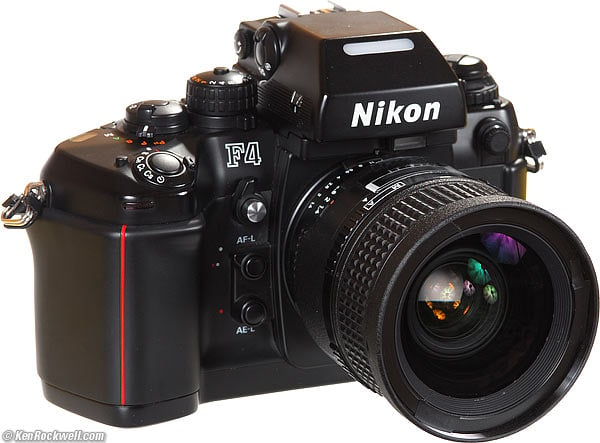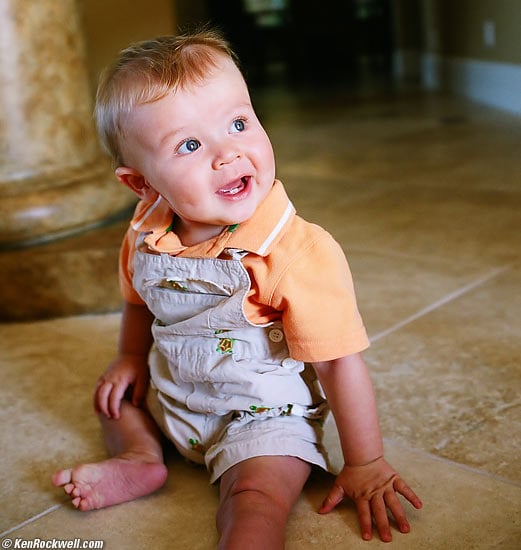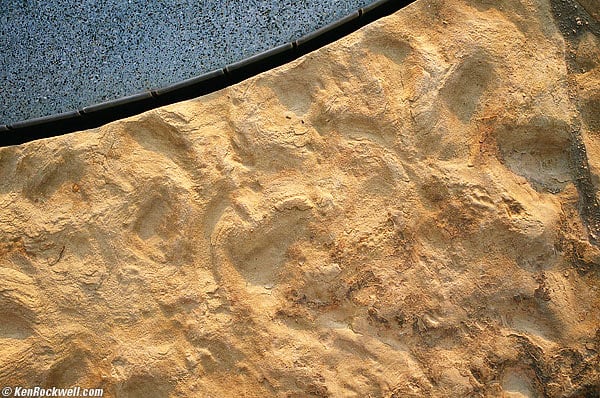Home Donate New Search Gallery Reviews How-To Books Links Workshops About Contact
Shooting Film Digitally
© 2007-2013 KenRockwell.com. All rights reserved.
The indomitable Nikon F4, available used today for less than I paid for my last CF card.
This free website's biggest source of support is when you use those or any of these links when you get anything, regardless of the country in which you live — but I receive nothing for my efforts if you buy elsewhere. I'm not NPR; I get no government hand-outs and run no pledge drives to support my research, so please always use any of these links for the best prices and service whenever you get anything. Thanks for helping me help you! Ken.
Note: This article talks about shooting color print film and converting it to digital in an hour at Costco.
For serious photography, I use Fuji Velvia 50 slide film, and have it processed and scanned to digital at NCPS, who also does mail order. NCPS also develops 120, 4x5" and larger slide (E-6) and traditional black-and-white film, while Costco only develops 35mm color print (C-41) film. NCPS costs a little more than Costco, but can give even better results. Remember, most of this article is about free, but if you're willing to shell out a few extra dollars, go for NCPS if you prefer.
Shooting Fuji Velvia 50 and having the scans made at NCPS gives the same results as shooting an $8,000 Nikon D3X with 24MP.
July 2013 Better Pictures Nikon Canon Fuji LEICA All Reviews
|
Adorama pays top dollar for your used gear. I use these stores. I can't vouch for ads below. |
Now that people are unloading their old, unused gear on me, and that I'm buying it because it's so darn inexpensive, I've discovered that digital minilab technology has made shooting film much, much easier than it was when normal people stopped shooting it in 2003.
Today I can drop a roll of color print film at my local Price Club (called Costco outside of San Diego), and go to lunch. By the time I return, I have a gold archival CD loaded with high-resolution digital images and a set of great 5x7" prints for less than what they charge just to make those same prints from other digital files.
Here's the breakout: a 24 exposure roll of excellent Fuji 400 film sells, with a coupon, for a dollar a roll in six-packs. No coupon? Then it's a whopping $1.33.
The processing is $1.59, the prints are 15¢ each and the CD with the scans is $2.99, or a total of $8.18. Costco has a coupon for $1.50 running through most of September, so that means the complete cost for processing, printing and scanning is just $6.68. Add the cost of film and you're into it for only $7.68, or 32¢ a print, including film, processing, printing and scanning. I usually get 25 frames, which at only an extra 15¢ a print lowers the average cost to 31¢ a print. If I was a big spender and shot rolls of 36, it would be even less.
You walk away with your images archived three and a half ways: digital files, negatives, archival Fuji Crystal Archive prints, and an index print. The prints alone from digital files cost 39¢ for a 5x7," and usually run a dollar if you still use dedicated photo labs.
They do this for us while we shop or have lunch. Do you have any idea how long it would take me to do all that scanning and archiving myself?
The CDs are very nice. They are now imprinted with thumbnails of all the images.

CD with JPG files and imprinted thumbnails.
How Good Is It?
The CD is great. There are various bogus files on it, which for all I know include editing software. I ignore them. All I do is copy the JPGs from the QSS_CD > DCIM > 100NORIT folder to my computer. It's not like the old Kodak Photo CD which used bizarre file formats; these are universal high-quality JPGs.
The files are 4.5MB JPGs at 3,089 x 2,048 pixels. File size will vary with the detail of the image.
How good are the scans? I was amazed when I compared the scans from a $5 Olympus Trip-35 I got at a thrift store to files from my Canon 5D and L series lens. The $5 camera was sharper in the corners, and the images only cost me 58¢ a piece, including the camera! See my report on the Olympus Trip-35 to see the examples.
Ryan Rockwell, photographed with the Konica Hexar on Fuji 400.
It looks great to me. This is as shot and as scanned, no exposure or color tweaks. I shot the Hexar at around f/2.8, so the background is completely out of focus. Digital compacts can't do this. Here is the original 4.5MB JPG from Costco.
Film is grainier than files from a digital SLR, but about the same as files from a compact digital. These film scans are actually much cleaner than compact digital camera files, since they don't have the excessive noise reduction that smudges over textures in compact cameras. I like my Grain Surgery plug-in for cleaning up grainy film like this. I ran the plugin at 33% on the full size scan, and then cropped, resized and resharpened it above. The original 4.5MB JPG is untouched.
So far my results have been contrastier than I prefer, with somewhat redder skin tones. I'm unsure if this is the way my Costco is calibrated, or more likely, simply my choice of film. I do need to try some Reala. I love the saturation.

Beach Towels at Costco, as shot and as scanned by Costco. (Hexar, Fuji 400)
The colors in this towel shot are almost scary. This is exactly as it came off the CD. I love it!
Last Light. (Hexar, Fuji 400) 6.6MB original
Last light looks great. I see none of the awful hue-shifted highlights so easy to get on digital cameras. Want to see detail from the old Hexar and the cheap film and scans? Have a look at Costco's original 6.6MB scan. The image above is also exactly as it came from Costco, except for resizing.
These negative scans appear to have better highlight blow-out handling than digital cameras.

Inside-outside shot with harsh subject contrast.
I'm not making this up. Here's a shot I made with and without fill flash. This is as it came off the CD, no twiddling with levels or color. This shot, without fill, looks perfectly natural. The fill-flash shot, not shown here, looked forced. Heck, I doubt I could have gotten this on a digital camera, although I didn't think to try. Next time I will.
These scans employ excellent auto white balance and exposure correction. Shooting negatives and dropping them off is like shooting raw and having the lab do all the color, WB and exposure corrections for you for free. Today's minilabs do some very clever things to alter contrast and color, so depending on where you go, you may be able to get a look you can't get any other way.
So far I haven't been geeky enough to run any serious tests. I've just been having a ball annoying my wife shooting with the Konica Hexar, which she hates because it looks old to her.
Film Types
I have not tried this with better, slower film.
I've only used the ISO 400 Fuji film I got at Costco.
If I got serious about this, I'd try my favorite color negative film, Fuji ISO 100 Reala.
Filing Digital Files
I copy the files from the CD into my computer and archive them in the same folders as my traditional digital camera shots. It makes no difference to me. I ingest them and they are treated the same way. If anything, it's easier to pop in a CD than to plug in a camera.
If I had no computer, I'd use the index prints included to sort, and then print from the CD at Costco's Kiosks.
I have a ball every time I order prints at Costco. Their kiosks make it easy to get exact crops to fit the prints to the paper sizes. I don't have to use a computer to get perfect crops and rotations.
Your Local Costco
I get different results depending on the Costco I try. Some gave lower resolution CDs depending on the original print sizes I ordered. At some Costcos you may need to ask specifically for High-Rez scans.
If you're not happy with what you get, ask, and if they're not making you happy, try another Costco or another lab. Just like everything in analog and film, everything matters. I'd try Wal-Mart, too, if I was near one.
I found that the Costco down the street from Nikon USA's headquarters in Melville, Long Island, NY also offers print sizes I can't get at my store in California. They offer 12 x 24" and 12 x 36" panoramic prints for $3.99 and $4.99. All the stores offer 12 x 18" prints for $2.99, my favorite print size.
Slides
Sadly, Costco doesn't run E-6, so my Velvia goes to a real lab.
Costco will scan my slides for 29¢ a slide, with no charge for the CD.
Unfortunately, the colors were great, but the resolution was sloppy. The images were 3,000 x 2,000 pixels, but appeared to be nearest-neighbor (blocky) upsampled to that size. This is a great way to scan for the web, but not for the serious stuff for which we shoot slides.
So where's the free part?
This system of having Costco process my film and scan it costs less per print than the cost of the prints alone. That's less than free!
Want a top-level professional camera? I'd suggest a used Nikon F4, which you can get for less than I paid for my last CF card, just a couple of hundred dollars. If all you've ever used are mid-level digital cameras like the D200, the no-holds-barred professional F4 makes my D200 feel like a toy.
Want a lightweight take-along? Get a used Nikon N75, or any of the great film classics. I got my mom a used N55.
Today the used prices of all film cameras are so cheap that it doesn't cost much more to own a professional flagship Nikon like the F, F2, F3, F4 or even F5 than it does to buy one of the dinky N-series film cameras. Only the F6 still costs real money as of 2008.
I've been shooting this film in an old classic Konica Hexar which is here at The Ranch, full report coming.
This makes you money. You could follow everyone else with all this digital madness of blowing four figures on even the cheapest mid-line amateur digital camera every year and a half, or spend a few hundred dollars on a timeless film classic and be set for a decade. Guess what: when you tire of the camera, your film classic will probably be worth what you paid for it, while your digital will probably be worth less than the film classic.
Even Cheaper than Free Solutions
This is cheap enough for me, and I like to see what I shot at 5x7."
If I was even cheaper, I could have them printed at just 4x6," or probably ask for no prints at all.
I ask for 5x7" because I prefer them. Depending on your Costco, I've seen scanned files come out smaller when I ordered 4x6" prints instead of 5x7."
The Full-Frame Advantage
You can read my Full-Frame Advantage article, but the real advantages here are for convenience, cost, ability to use any old film camera, and ultra-wide angle lenses which are not available for DX cameras.
I'm going to be testing them against each other, but a $5,000 Nikon D3 or $2,500 Canon 5D should give a much cleaner, grain-free image than these film scans from Costco. Film isn't as clean as digital; digital sensors of the same size are more efficient with photons.
Try it. If you like it, I just saved you $5,000 for a Nikon D3, and a lot more from day-to-day as you print.
You do have to buy into being a Costco member for an annual tab. My wife is a member, so I married her so I could get in for free.
Not that this is the best solution for a serious pro, but it is a great solution for normal people who want to capture digital files easily and quickly. It's also a great idea for people who need handy digital files and want a film camera's flexibility and speed, but don't feel like throwing away a grand or more every year or so just to stay current.
There are other advantages, like never missing a new shot while looking at an old one on the back of the camera. No vacation nights wasted piddling on a laptop to download and organize everything. No wasting time with amateur DSLRs like the D300 and being able to step up to a battle-hardened F4 or F5 with their scaldingly fast autofocus and shutter release.
Want to hit the jungle for a year? If I was out where there was no electricity to recharge my digital camera batteries, the Konica Hexar (review coming) claims to shoot 200 24-exposure rolls on a single tiny, lightweight $2 CR2 throw-away lithium battery. I could jam my pockets full of film and a couple of batteries and hit the road for a long time without having to come up for air. The landmark Nikon F3 (or its little brother the FE or FE2) runs for a year or more on two tiny A76 watch batteries, which I buy over the Internet for 80¢ the pair. If I was in the woods, I'd drop a spare set in my wallet.
These examples are from just a few trial rolls of film I blew through a Konica Hexar I'm testing. Picking the good ones to show here, even I'm impressed.
I prefer Fuji Velvia for my landscape work, but for snapshots or budget digital, give this system a try.
I use Costco. Every other lab today offers similar services, although they may not be as good or as inexpensive. I've always been embarrassed when I paid extra for pro labs to process my negatives, and my pals got better results at Costco. It's inexpensive, and good.
Services for Pros
For slides, and definitely not inexpensive, I've heard from a friend who uses them that The Icon lab in Los Angeles will take your film and do everything.
If you're in LA, they'll send a courier to get your film, process it, scan it and put the images for you to see via the internet. You then tell them what to do with what: trash them, archive them, print them, drum scan them, or whatever. They even will take care of my least favorite aspect, storing it. They'll store it and index your film in their vaults for you.
Icon is a premium service not for everyone, but the great news is that even if you're out of LA and mail them your film, you can get the quality of film with the convenience of digital, so long as you're willing to pay for it.
The funny thing was that my friend who uses them explained it all this simply, but when I phoned them to confirm that I was putting up the correct link, they didn't quite see it that clearly. You'll haveto set up accounts and ask a bunch of questions to get it set up this smoothly.
Sunny México
You're even better off in México. A reader from Monterrey writes that the Costco there does this for 29.90MXN (~2.70USD) including development and cost of CD burning, also all done on Noritsu.
Down there one can buy a 4 pack of Fuji ProPlus 100 for 64MXN, and develop and get a CD with scans for 29.90MXN. The total cost per frame is then 1.28MXN which is 11¢ US. If you want 4x6 prints, you could add those for 1MXN per frame.
I wonder if I can do it online from the USA?
Help me help you top
I support my growing family through this website, as crazy as it might seem.
The biggest help is when you use any of these links when you get anything, regardless of the country in which you live. It costs you nothing, and is this site's, and thus my family's, biggest source of support. These places have the best prices and service, which is why I've used them since before this website existed. I recommend them all personally.
If you find this page as helpful as a book you might have had to buy or a workshop you may have had to take, feel free to help me continue helping everyone.
If you've gotten your gear through one of my links or helped otherwise, you're family. It's great people like you who allow me to keep adding to this site full-time. Thanks!
If you haven't helped yet, please do, and consider helping me with a gift of $5.00.
As this page is copyrighted and formally registered, it is unlawful to make copies, especially in the form of printouts for personal use. If you wish to make a printout for personal use, you are granted one-time permission only if you PayPal me $5.00 per printout or part thereof. Thank you!
Thanks for reading!
Mr. & Mrs. Ken Rockwell, Ryan and Katie.
Home Donate New Search Gallery Reviews How-To Books Links Workshops About Contact





